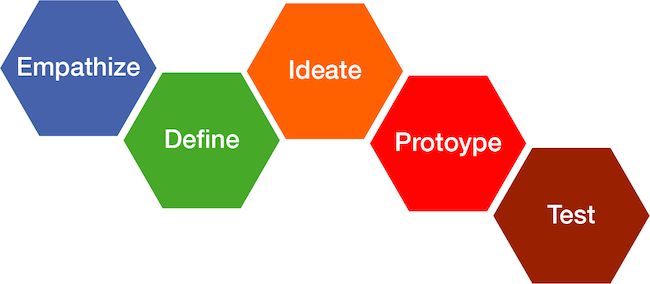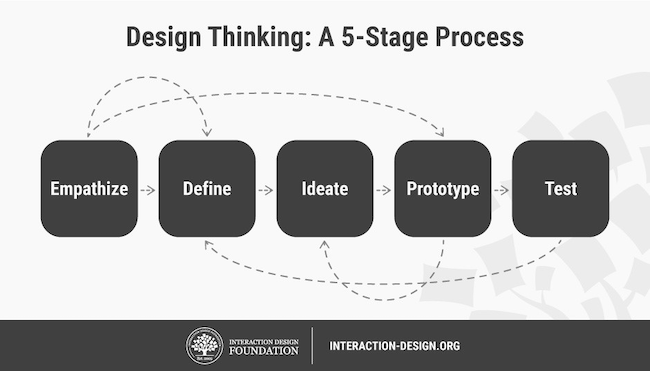Human-Centered Design
IDEO provides a good definition of human-centered design.
Human-centered design is a creative approach to problem solving. … It’s a process that starts with the people you’re designing with and ends with new solutions that are purpose-built to suit their needs. Human-centered design is about cultivating deep empathy with the people you’re designing with; generating ideas; building a bunch of prototypes; sharing what you’ve made together; and eventually, putting your innovative new solution out in the world.
Oregon MESA has a detailed Invention Toolkit that focuses on human-centered design.
Table of contents
- Visual Images of the design process
- Begin with and maintain empathy
- Name or define the problem
- Ideation
- Using prototypes to express and test ideas
- Iteration
Visual Images of the design process
We have a separate page that uses graphical images to represent the design process. We will use the following visual model to guide our presentation.

Begin with and maintain empathy
The human-centered design process focuses on people. We seek to understand their circumstances and how, or even whether, an invention might improve those circumstances.
By keeping people at the center of our attention, we hope to avoid inventing a solution that doesn’t, in the end, help. We humans have created many inventions that caused more and bigger problems than those same inventions have solved.
Name or define the problem
The “problem” is an aspect of a human circumstance that might be improved by an invention. The problem may be an obstacle, for example a lack of resources, or a bad outcome, for example pollution, that would be good to reduce or eliminate.
Alternatively, the problem could be an opportunity to make something better, for example inventing an inexpensive kit that allows students to do science experiments in their own home.
Carefully defining the problem gives us a good starting point for using creativity to imagine solutions.
Ideation
When we understand the problem we can then use our creativity to imagine ways to make the circumstances better, to “solve” the problem. Ideation is the the process of generating ideas that address the problem. This can be a fun and inspiring part of the design process.
There are many tools of ideation, including
- Sketching
- Brainstorming and brainwriting
- Role-playing (of your client in scenarios)
- Storyboarding (to create a story/movie about the problem)
- SCAMPER (Substitute, Combine, Adapt, Modify, Put to another use, Reverse/Rearrange
- Mash-up (combine ideas)
Each of these techniques requires more explanation than we offer here. The key idea is that can and should use more than just brainstorming to come up with ideas.
Using prototypes to express and test ideas
Ideation generates possible solutions. We experiment with those solutions by creating prototypes – early trial versions of our invention – and test those prototypes. The ideation process involves
- Creating prototypes of inventions
- Testing and refining the prototypes
- Seeking feedback and iterating
If our invention is a physical object, it is helpful to keep the prototypes simple at first. For example, paper and cardboard mockups can be created that don’t actually work, but instead represent how the invention might work. Mockups encourage experimentation with many ideas quickly and at low cost.
Ideation and experimentation are synergistic. By experimenting, we can create new ideas.
As the ideas are refined, our prototypes become for realistic. At all stages of prototype development it is wise to seek feedback from potential users. The goal is not to “sell” them on our ideas. The goal is use the prototypes to elicit deeper understanding of the problem we addressing and how an invention might help with that problem.
Iteration
The design process outlined above might give you the impression that design is an orderly sequence of steps. That is usually not the case. Design is often a messy process. Especially in the early stages we can spend a lot of time figuring out what doesn’t work.
Iteration is the process of repeating and refining our ideas. Iteration can happen during and between the stages described above. The following image from the Interaction Design Foundation expresses the non-linear, non-sequential nature of the design process.

Credit Interaction Design Foundation